Fire and Ice Business Toolkit Report: Financial, HR, and Legal Aspects
VerifiedAdded on 2022/11/28
|14
|3411
|215
Report
AI Summary
This report provides a comprehensive analysis of a hospitality business toolkit, using Fire and Ice as a case study. It begins by exploring principles of financial performance management, including budgeting, financial statements, and cost analysis. The report then delves into the HR life cycle, focusing on talent acquisition, retention, and performance management plans within the food and beverage sector. Key legislation impacting hospitality organizations, such as the Equality Act and Data Protection Act, are examined, alongside the impact of contracts and employment on business decision-making. Finally, the report covers various functional roles within the hospitality sector and communication methods. The report aims to provide a practical guide for improving financial performance, managing human resources, and ensuring legal compliance in the hospitality industry.

Hospitality Business
Toolkit
Toolkit
Paraphrase This Document
Need a fresh take? Get an instant paraphrase of this document with our AI Paraphraser


Contents
INTRODUCTION........................................................................................................... 3
TASK 1........................................................................................................................ 3
Principles of managing and monitoring financial performance...............................3
Principles of double entry bookkeeping system of debits and credits.....................4
Produce a basic trial balance applying the use of the balance off rule to complete
the ledger................................................................................................................ 4
Analyse types of cost and how they can be managed to influence the financial
performance............................................................................................................ 5
TASK 2........................................................................................................................ 5
Different stages of the HR life cycle as applied issues in talent acquisition and
retention within the food and beverage sector.......................................................5
Develop performance management plan................................................................7
TASK 3........................................................................................................................ 8
Specific legislation for hospitality organizations......................................................8
Impact of contract and employment on business decision making.........................9
TASK 4........................................................................................................................ 9
Different Functional role within the hospitality sector.............................................9
Communication methods and levels used in an organisation...............................10
CONCLUSION............................................................................................................ 11
REFERENCES............................................................................................................ 12
INTRODUCTION........................................................................................................... 3
TASK 1........................................................................................................................ 3
Principles of managing and monitoring financial performance...............................3
Principles of double entry bookkeeping system of debits and credits.....................4
Produce a basic trial balance applying the use of the balance off rule to complete
the ledger................................................................................................................ 4
Analyse types of cost and how they can be managed to influence the financial
performance............................................................................................................ 5
TASK 2........................................................................................................................ 5
Different stages of the HR life cycle as applied issues in talent acquisition and
retention within the food and beverage sector.......................................................5
Develop performance management plan................................................................7
TASK 3........................................................................................................................ 8
Specific legislation for hospitality organizations......................................................8
Impact of contract and employment on business decision making.........................9
TASK 4........................................................................................................................ 9
Different Functional role within the hospitality sector.............................................9
Communication methods and levels used in an organisation...............................10
CONCLUSION............................................................................................................ 11
REFERENCES............................................................................................................ 12
⊘ This is a preview!⊘
Do you want full access?
Subscribe today to unlock all pages.

Trusted by 1+ million students worldwide
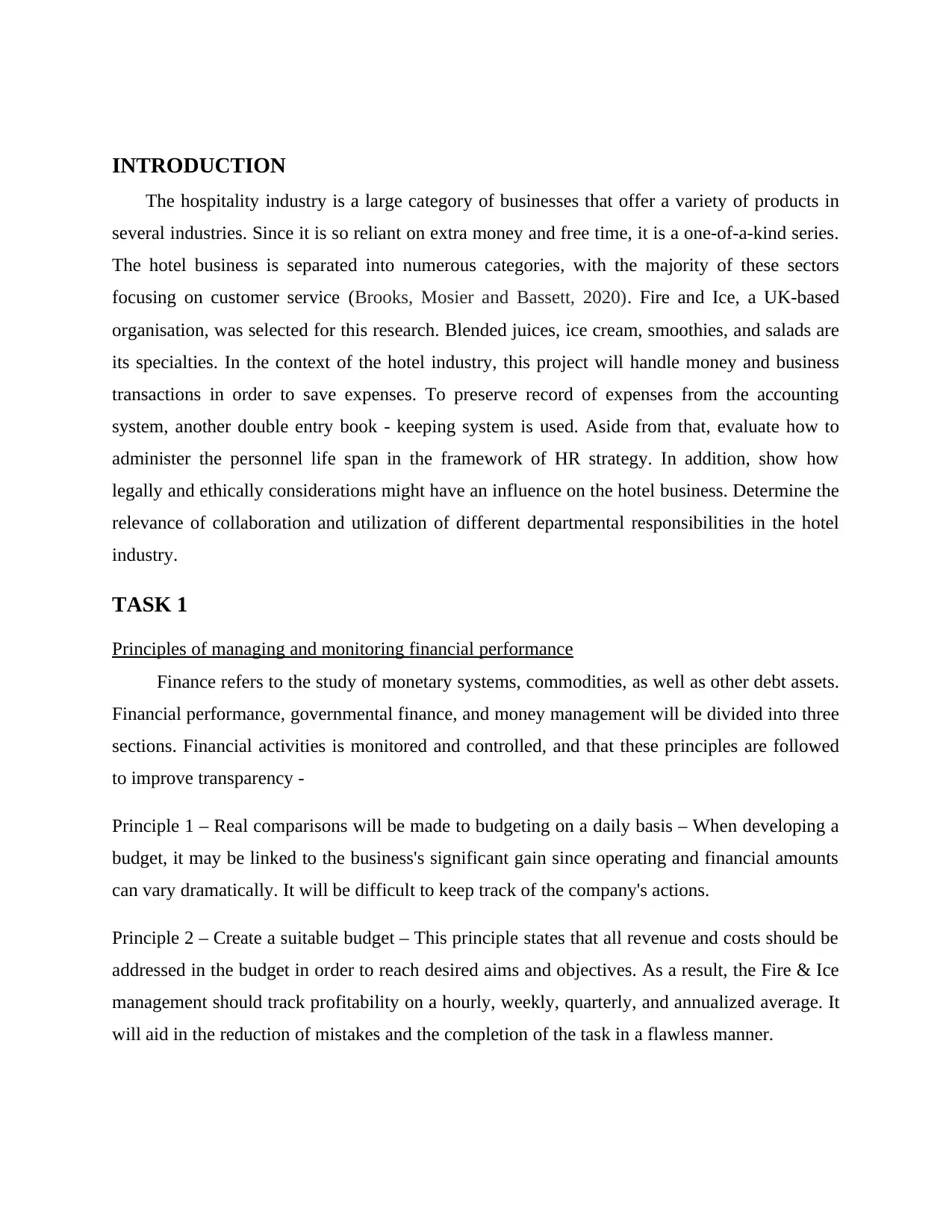
INTRODUCTION
The hospitality industry is a large category of businesses that offer a variety of products in
several industries. Since it is so reliant on extra money and free time, it is a one-of-a-kind series.
The hotel business is separated into numerous categories, with the majority of these sectors
focusing on customer service (Brooks, Mosier and Bassett, 2020). Fire and Ice, a UK-based
organisation, was selected for this research. Blended juices, ice cream, smoothies, and salads are
its specialties. In the context of the hotel industry, this project will handle money and business
transactions in order to save expenses. To preserve record of expenses from the accounting
system, another double entry book - keeping system is used. Aside from that, evaluate how to
administer the personnel life span in the framework of HR strategy. In addition, show how
legally and ethically considerations might have an influence on the hotel business. Determine the
relevance of collaboration and utilization of different departmental responsibilities in the hotel
industry.
TASK 1
Principles of managing and monitoring financial performance
Finance refers to the study of monetary systems, commodities, as well as other debt assets.
Financial performance, governmental finance, and money management will be divided into three
sections. Financial activities is monitored and controlled, and that these principles are followed
to improve transparency -
Principle 1 – Real comparisons will be made to budgeting on a daily basis – When developing a
budget, it may be linked to the business's significant gain since operating and financial amounts
can vary dramatically. It will be difficult to keep track of the company's actions.
Principle 2 – Create a suitable budget – This principle states that all revenue and costs should be
addressed in the budget in order to reach desired aims and objectives. As a result, the Fire & Ice
management should track profitability on a hourly, weekly, quarterly, and annualized average. It
will aid in the reduction of mistakes and the completion of the task in a flawless manner.
The hospitality industry is a large category of businesses that offer a variety of products in
several industries. Since it is so reliant on extra money and free time, it is a one-of-a-kind series.
The hotel business is separated into numerous categories, with the majority of these sectors
focusing on customer service (Brooks, Mosier and Bassett, 2020). Fire and Ice, a UK-based
organisation, was selected for this research. Blended juices, ice cream, smoothies, and salads are
its specialties. In the context of the hotel industry, this project will handle money and business
transactions in order to save expenses. To preserve record of expenses from the accounting
system, another double entry book - keeping system is used. Aside from that, evaluate how to
administer the personnel life span in the framework of HR strategy. In addition, show how
legally and ethically considerations might have an influence on the hotel business. Determine the
relevance of collaboration and utilization of different departmental responsibilities in the hotel
industry.
TASK 1
Principles of managing and monitoring financial performance
Finance refers to the study of monetary systems, commodities, as well as other debt assets.
Financial performance, governmental finance, and money management will be divided into three
sections. Financial activities is monitored and controlled, and that these principles are followed
to improve transparency -
Principle 1 – Real comparisons will be made to budgeting on a daily basis – When developing a
budget, it may be linked to the business's significant gain since operating and financial amounts
can vary dramatically. It will be difficult to keep track of the company's actions.
Principle 2 – Create a suitable budget – This principle states that all revenue and costs should be
addressed in the budget in order to reach desired aims and objectives. As a result, the Fire & Ice
management should track profitability on a hourly, weekly, quarterly, and annualized average. It
will aid in the reduction of mistakes and the completion of the task in a flawless manner.
Paraphrase This Document
Need a fresh take? Get an instant paraphrase of this document with our AI Paraphraser
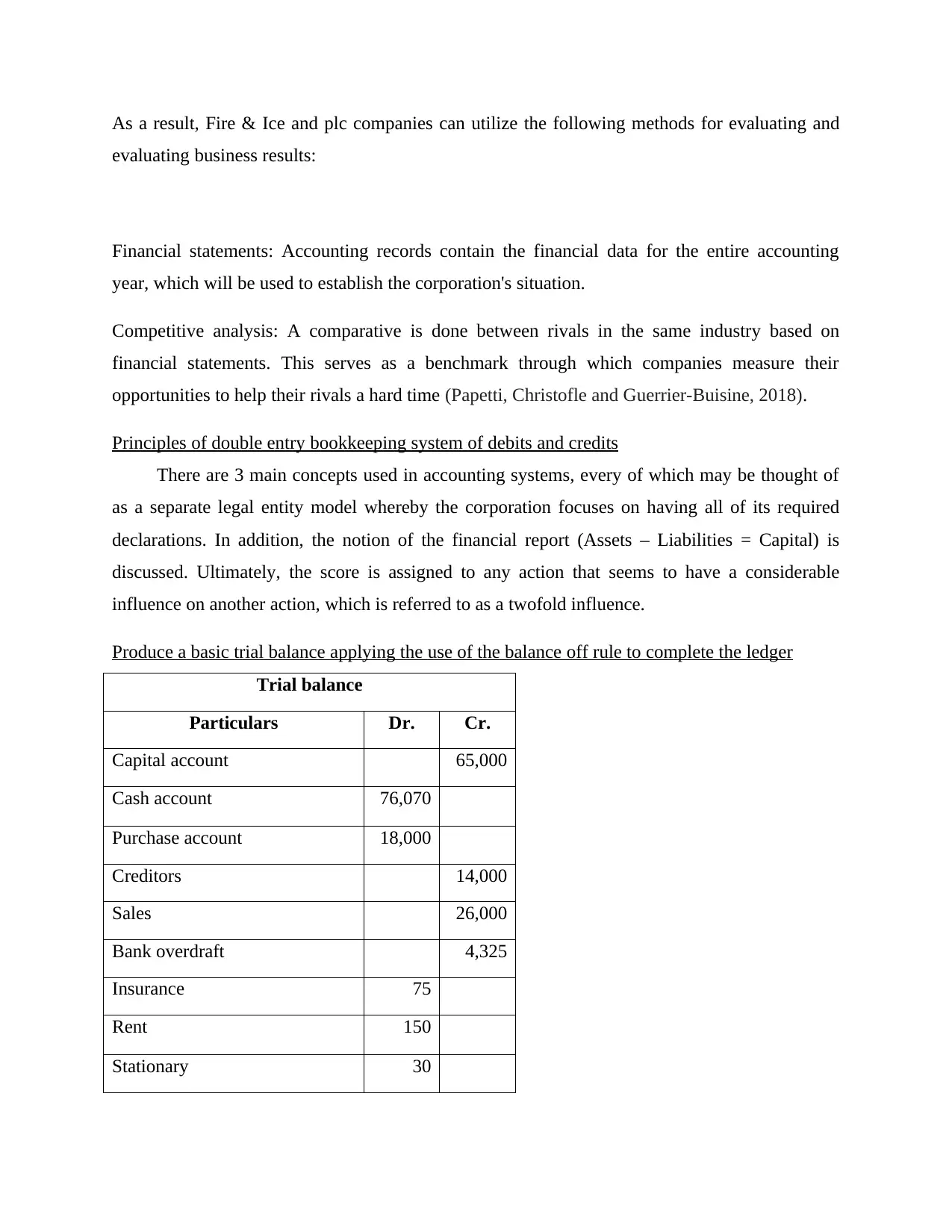
As a result, Fire & Ice and plc companies can utilize the following methods for evaluating and
evaluating business results:
Financial statements: Accounting records contain the financial data for the entire accounting
year, which will be used to establish the corporation's situation.
Competitive analysis: A comparative is done between rivals in the same industry based on
financial statements. This serves as a benchmark through which companies measure their
opportunities to help their rivals a hard time (Papetti, Christofle and Guerrier-Buisine, 2018).
Principles of double entry bookkeeping system of debits and credits
There are 3 main concepts used in accounting systems, every of which may be thought of
as a separate legal entity model whereby the corporation focuses on having all of its required
declarations. In addition, the notion of the financial report (Assets – Liabilities = Capital) is
discussed. Ultimately, the score is assigned to any action that seems to have a considerable
influence on another action, which is referred to as a twofold influence.
Produce a basic trial balance applying the use of the balance off rule to complete the ledger
Trial balance
Particulars Dr. Cr.
Capital account 65,000
Cash account 76,070
Purchase account 18,000
Creditors 14,000
Sales 26,000
Bank overdraft 4,325
Insurance 75
Rent 150
Stationary 30
evaluating business results:
Financial statements: Accounting records contain the financial data for the entire accounting
year, which will be used to establish the corporation's situation.
Competitive analysis: A comparative is done between rivals in the same industry based on
financial statements. This serves as a benchmark through which companies measure their
opportunities to help their rivals a hard time (Papetti, Christofle and Guerrier-Buisine, 2018).
Principles of double entry bookkeeping system of debits and credits
There are 3 main concepts used in accounting systems, every of which may be thought of
as a separate legal entity model whereby the corporation focuses on having all of its required
declarations. In addition, the notion of the financial report (Assets – Liabilities = Capital) is
discussed. Ultimately, the score is assigned to any action that seems to have a considerable
influence on another action, which is referred to as a twofold influence.
Produce a basic trial balance applying the use of the balance off rule to complete the ledger
Trial balance
Particulars Dr. Cr.
Capital account 65,000
Cash account 76,070
Purchase account 18,000
Creditors 14,000
Sales 26,000
Bank overdraft 4,325
Insurance 75
Rent 150
Stationary 30
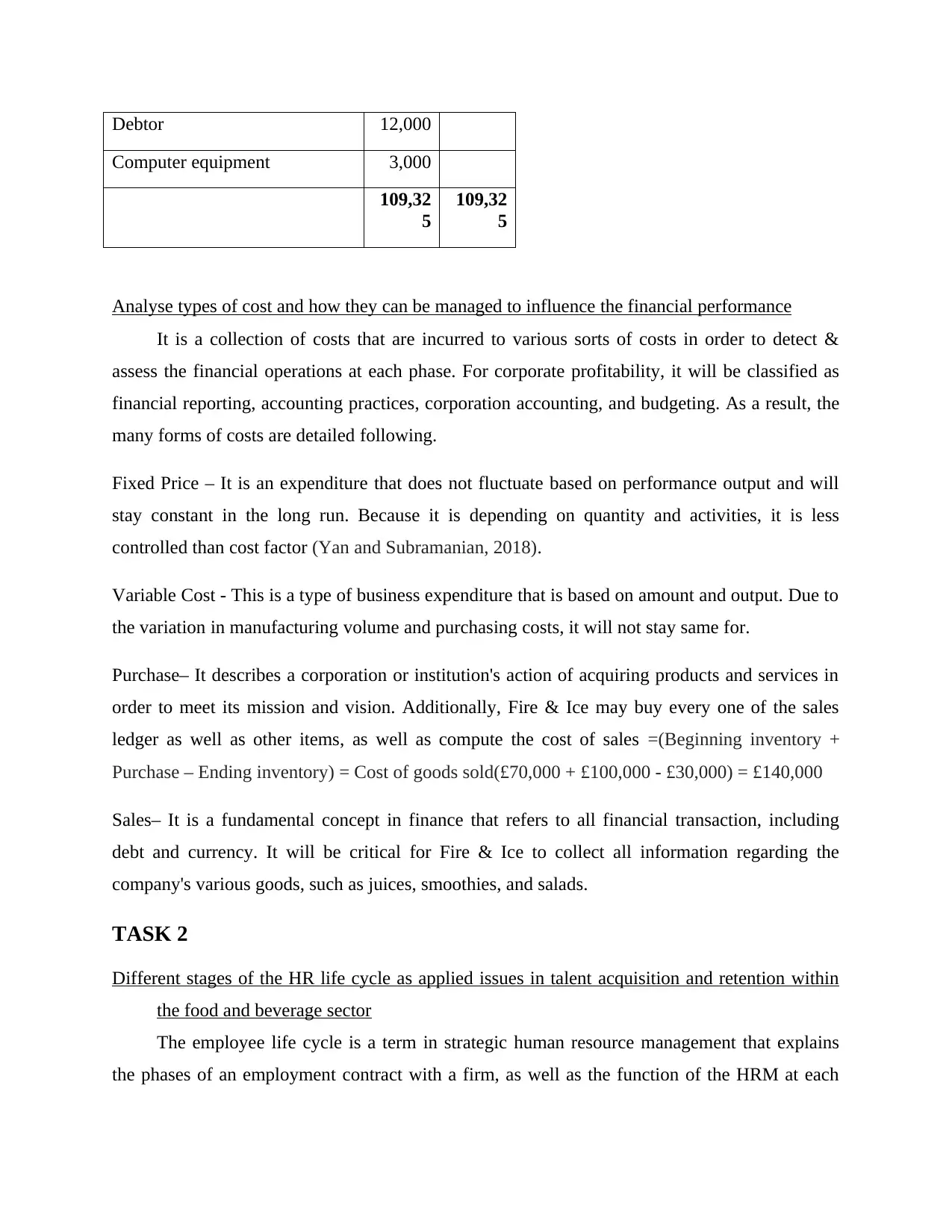
Debtor 12,000
Computer equipment 3,000
109,32
5
109,32
5
Analyse types of cost and how they can be managed to influence the financial performance
It is a collection of costs that are incurred to various sorts of costs in order to detect &
assess the financial operations at each phase. For corporate profitability, it will be classified as
financial reporting, accounting practices, corporation accounting, and budgeting. As a result, the
many forms of costs are detailed following.
Fixed Price – It is an expenditure that does not fluctuate based on performance output and will
stay constant in the long run. Because it is depending on quantity and activities, it is less
controlled than cost factor (Yan and Subramanian, 2018).
Variable Cost - This is a type of business expenditure that is based on amount and output. Due to
the variation in manufacturing volume and purchasing costs, it will not stay same for.
Purchase– It describes a corporation or institution's action of acquiring products and services in
order to meet its mission and vision. Additionally, Fire & Ice may buy every one of the sales
ledger as well as other items, as well as compute the cost of sales =(Beginning inventory +
Purchase – Ending inventory) = Cost of goods sold(£70,000 + £100,000 - £30,000) = £140,000
Sales– It is a fundamental concept in finance that refers to all financial transaction, including
debt and currency. It will be critical for Fire & Ice to collect all information regarding the
company's various goods, such as juices, smoothies, and salads.
TASK 2
Different stages of the HR life cycle as applied issues in talent acquisition and retention within
the food and beverage sector
The employee life cycle is a term in strategic human resource management that explains
the phases of an employment contract with a firm, as well as the function of the HRM at each
Computer equipment 3,000
109,32
5
109,32
5
Analyse types of cost and how they can be managed to influence the financial performance
It is a collection of costs that are incurred to various sorts of costs in order to detect &
assess the financial operations at each phase. For corporate profitability, it will be classified as
financial reporting, accounting practices, corporation accounting, and budgeting. As a result, the
many forms of costs are detailed following.
Fixed Price – It is an expenditure that does not fluctuate based on performance output and will
stay constant in the long run. Because it is depending on quantity and activities, it is less
controlled than cost factor (Yan and Subramanian, 2018).
Variable Cost - This is a type of business expenditure that is based on amount and output. Due to
the variation in manufacturing volume and purchasing costs, it will not stay same for.
Purchase– It describes a corporation or institution's action of acquiring products and services in
order to meet its mission and vision. Additionally, Fire & Ice may buy every one of the sales
ledger as well as other items, as well as compute the cost of sales =(Beginning inventory +
Purchase – Ending inventory) = Cost of goods sold(£70,000 + £100,000 - £30,000) = £140,000
Sales– It is a fundamental concept in finance that refers to all financial transaction, including
debt and currency. It will be critical for Fire & Ice to collect all information regarding the
company's various goods, such as juices, smoothies, and salads.
TASK 2
Different stages of the HR life cycle as applied issues in talent acquisition and retention within
the food and beverage sector
The employee life cycle is a term in strategic human resource management that explains
the phases of an employment contract with a firm, as well as the function of the HRM at each
⊘ This is a preview!⊘
Do you want full access?
Subscribe today to unlock all pages.

Trusted by 1+ million students worldwide
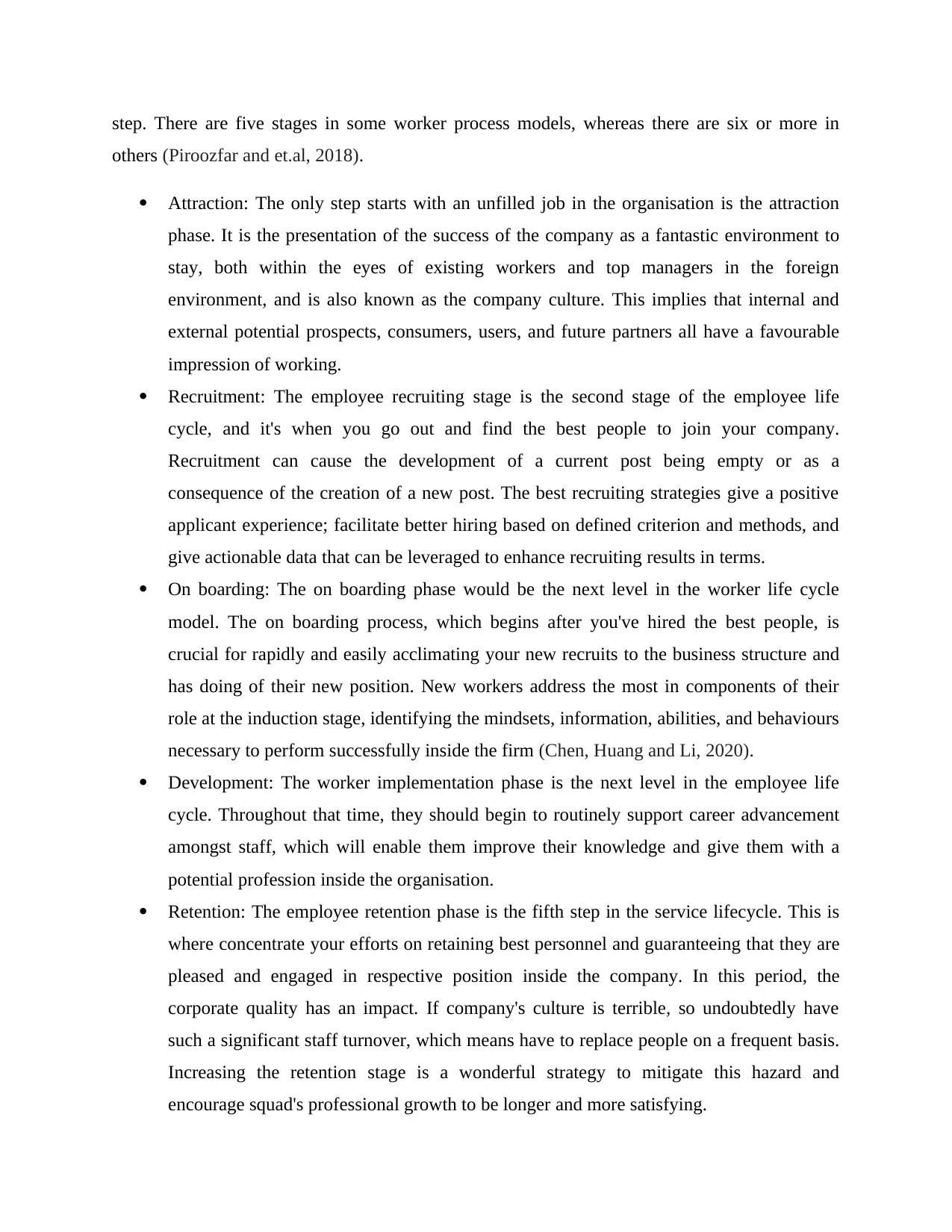
step. There are five stages in some worker process models, whereas there are six or more in
others (Piroozfar and et.al, 2018).
Attraction: The only step starts with an unfilled job in the organisation is the attraction
phase. It is the presentation of the success of the company as a fantastic environment to
stay, both within the eyes of existing workers and top managers in the foreign
environment, and is also known as the company culture. This implies that internal and
external potential prospects, consumers, users, and future partners all have a favourable
impression of working.
Recruitment: The employee recruiting stage is the second stage of the employee life
cycle, and it's when you go out and find the best people to join your company.
Recruitment can cause the development of a current post being empty or as a
consequence of the creation of a new post. The best recruiting strategies give a positive
applicant experience; facilitate better hiring based on defined criterion and methods, and
give actionable data that can be leveraged to enhance recruiting results in terms.
On boarding: The on boarding phase would be the next level in the worker life cycle
model. The on boarding process, which begins after you've hired the best people, is
crucial for rapidly and easily acclimating your new recruits to the business structure and
has doing of their new position. New workers address the most in components of their
role at the induction stage, identifying the mindsets, information, abilities, and behaviours
necessary to perform successfully inside the firm (Chen, Huang and Li, 2020).
Development: The worker implementation phase is the next level in the employee life
cycle. Throughout that time, they should begin to routinely support career advancement
amongst staff, which will enable them improve their knowledge and give them with a
potential profession inside the organisation.
Retention: The employee retention phase is the fifth step in the service lifecycle. This is
where concentrate your efforts on retaining best personnel and guaranteeing that they are
pleased and engaged in respective position inside the company. In this period, the
corporate quality has an impact. If company's culture is terrible, so undoubtedly have
such a significant staff turnover, which means have to replace people on a frequent basis.
Increasing the retention stage is a wonderful strategy to mitigate this hazard and
encourage squad's professional growth to be longer and more satisfying.
others (Piroozfar and et.al, 2018).
Attraction: The only step starts with an unfilled job in the organisation is the attraction
phase. It is the presentation of the success of the company as a fantastic environment to
stay, both within the eyes of existing workers and top managers in the foreign
environment, and is also known as the company culture. This implies that internal and
external potential prospects, consumers, users, and future partners all have a favourable
impression of working.
Recruitment: The employee recruiting stage is the second stage of the employee life
cycle, and it's when you go out and find the best people to join your company.
Recruitment can cause the development of a current post being empty or as a
consequence of the creation of a new post. The best recruiting strategies give a positive
applicant experience; facilitate better hiring based on defined criterion and methods, and
give actionable data that can be leveraged to enhance recruiting results in terms.
On boarding: The on boarding phase would be the next level in the worker life cycle
model. The on boarding process, which begins after you've hired the best people, is
crucial for rapidly and easily acclimating your new recruits to the business structure and
has doing of their new position. New workers address the most in components of their
role at the induction stage, identifying the mindsets, information, abilities, and behaviours
necessary to perform successfully inside the firm (Chen, Huang and Li, 2020).
Development: The worker implementation phase is the next level in the employee life
cycle. Throughout that time, they should begin to routinely support career advancement
amongst staff, which will enable them improve their knowledge and give them with a
potential profession inside the organisation.
Retention: The employee retention phase is the fifth step in the service lifecycle. This is
where concentrate your efforts on retaining best personnel and guaranteeing that they are
pleased and engaged in respective position inside the company. In this period, the
corporate quality has an impact. If company's culture is terrible, so undoubtedly have
such a significant staff turnover, which means have to replace people on a frequent basis.
Increasing the retention stage is a wonderful strategy to mitigate this hazard and
encourage squad's professional growth to be longer and more satisfying.
Paraphrase This Document
Need a fresh take? Get an instant paraphrase of this document with our AI Paraphraser
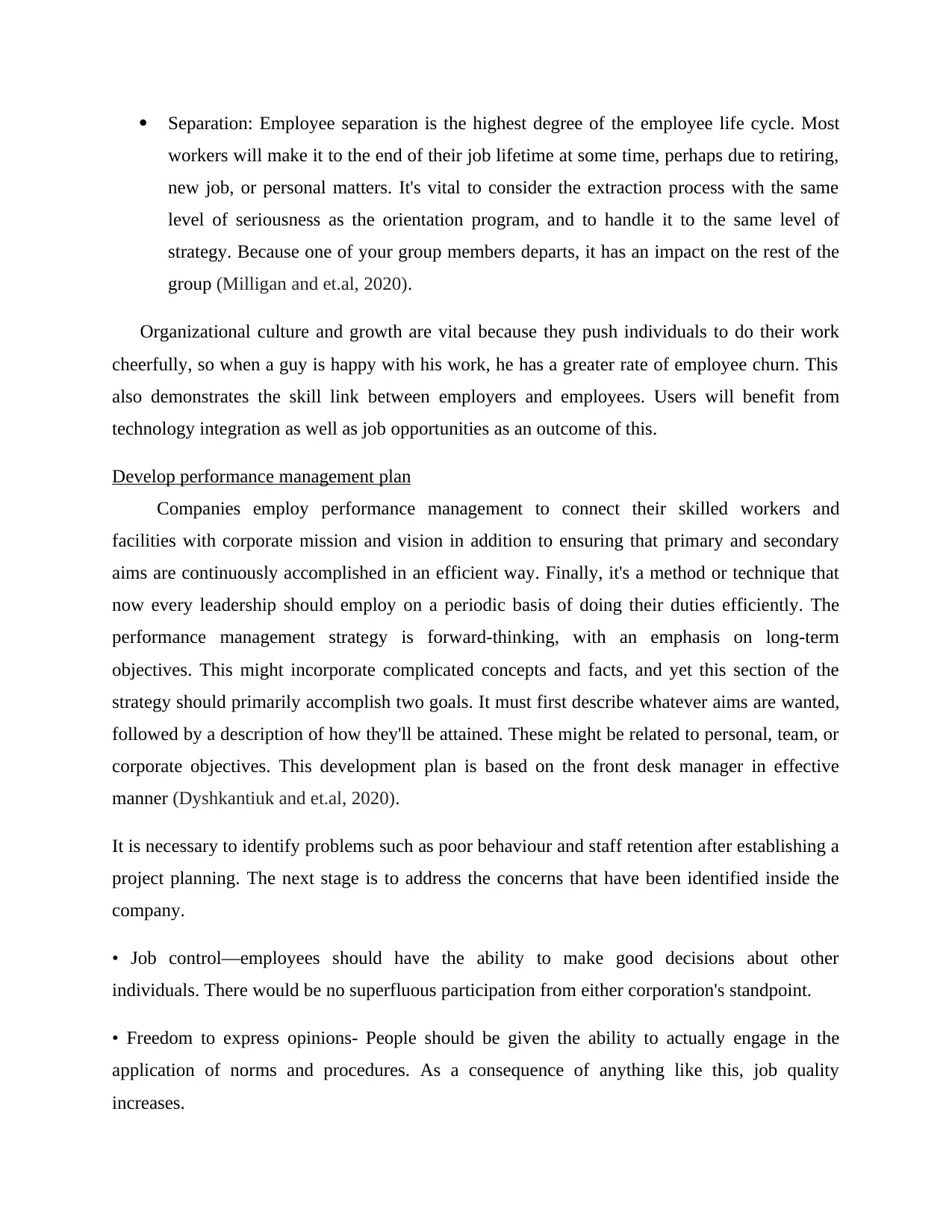
Separation: Employee separation is the highest degree of the employee life cycle. Most
workers will make it to the end of their job lifetime at some time, perhaps due to retiring,
new job, or personal matters. It's vital to consider the extraction process with the same
level of seriousness as the orientation program, and to handle it to the same level of
strategy. Because one of your group members departs, it has an impact on the rest of the
group (Milligan and et.al, 2020).
Organizational culture and growth are vital because they push individuals to do their work
cheerfully, so when a guy is happy with his work, he has a greater rate of employee churn. This
also demonstrates the skill link between employers and employees. Users will benefit from
technology integration as well as job opportunities as an outcome of this.
Develop performance management plan
Companies employ performance management to connect their skilled workers and
facilities with corporate mission and vision in addition to ensuring that primary and secondary
aims are continuously accomplished in an efficient way. Finally, it's a method or technique that
now every leadership should employ on a periodic basis of doing their duties efficiently. The
performance management strategy is forward-thinking, with an emphasis on long-term
objectives. This might incorporate complicated concepts and facts, and yet this section of the
strategy should primarily accomplish two goals. It must first describe whatever aims are wanted,
followed by a description of how they'll be attained. These might be related to personal, team, or
corporate objectives. This development plan is based on the front desk manager in effective
manner (Dyshkantiuk and et.al, 2020).
It is necessary to identify problems such as poor behaviour and staff retention after establishing a
project planning. The next stage is to address the concerns that have been identified inside the
company.
• Job control—employees should have the ability to make good decisions about other
individuals. There would be no superfluous participation from either corporation's standpoint.
• Freedom to express opinions- People should be given the ability to actually engage in the
application of norms and procedures. As a consequence of anything like this, job quality
increases.
workers will make it to the end of their job lifetime at some time, perhaps due to retiring,
new job, or personal matters. It's vital to consider the extraction process with the same
level of seriousness as the orientation program, and to handle it to the same level of
strategy. Because one of your group members departs, it has an impact on the rest of the
group (Milligan and et.al, 2020).
Organizational culture and growth are vital because they push individuals to do their work
cheerfully, so when a guy is happy with his work, he has a greater rate of employee churn. This
also demonstrates the skill link between employers and employees. Users will benefit from
technology integration as well as job opportunities as an outcome of this.
Develop performance management plan
Companies employ performance management to connect their skilled workers and
facilities with corporate mission and vision in addition to ensuring that primary and secondary
aims are continuously accomplished in an efficient way. Finally, it's a method or technique that
now every leadership should employ on a periodic basis of doing their duties efficiently. The
performance management strategy is forward-thinking, with an emphasis on long-term
objectives. This might incorporate complicated concepts and facts, and yet this section of the
strategy should primarily accomplish two goals. It must first describe whatever aims are wanted,
followed by a description of how they'll be attained. These might be related to personal, team, or
corporate objectives. This development plan is based on the front desk manager in effective
manner (Dyshkantiuk and et.al, 2020).
It is necessary to identify problems such as poor behaviour and staff retention after establishing a
project planning. The next stage is to address the concerns that have been identified inside the
company.
• Job control—employees should have the ability to make good decisions about other
individuals. There would be no superfluous participation from either corporation's standpoint.
• Freedom to express opinions- People should be given the ability to actually engage in the
application of norms and procedures. As a consequence of anything like this, job quality
increases.

• Frequent and equitable treatment- A business should recruit people in a logical and rational
way. At all circumstances, judgment and bias should be resisted.
• Faith and respect- Focused on personal accomplishments and organisational accomplishments,
the employee should be treated with trust and confidence.
TASK 3
Specific legislation for hospitality organizations
There are mentioning different types of legislation that must use by the hospitality industry
are mentioned below:
• Equality Act 2010: This Act establishes a regulatory precedent to safeguard personal freedoms
and promote social justice for all. It establishes a discrimination legislation in the United
Kingdom that protects persons from unfair treatment and fosters a more just and equitable
society.
• Rehabilitation of Offenders Act of 1974: This law offers those with expunged offenses and
warnings the option of not disclosing them while looking for employment or purchasing
insurance.
• Data Protection Act of 2018: This Act provides consumers more control over the information
and help companies use knowledge more efficiently.
• The Employment Rights Act of 1996 covers a wide range of worker protections, includes
unjust dismissal, critical importance prior resignation, parental leave, severance, and also more.
• The 2002 Fixed-term Employees (Prohibition of Discriminatory Handling) Legislation: This
stipulates that a fixed-term employee shall not be regarded fewer generously than a similar new
graduate (O'Sullivan and et.al, 2018).
• The Part-Time Workers Regulation of 2000: This mandates that companies treat portion
employees in the same way as filled employees that do the same tasks.
way. At all circumstances, judgment and bias should be resisted.
• Faith and respect- Focused on personal accomplishments and organisational accomplishments,
the employee should be treated with trust and confidence.
TASK 3
Specific legislation for hospitality organizations
There are mentioning different types of legislation that must use by the hospitality industry
are mentioned below:
• Equality Act 2010: This Act establishes a regulatory precedent to safeguard personal freedoms
and promote social justice for all. It establishes a discrimination legislation in the United
Kingdom that protects persons from unfair treatment and fosters a more just and equitable
society.
• Rehabilitation of Offenders Act of 1974: This law offers those with expunged offenses and
warnings the option of not disclosing them while looking for employment or purchasing
insurance.
• Data Protection Act of 2018: This Act provides consumers more control over the information
and help companies use knowledge more efficiently.
• The Employment Rights Act of 1996 covers a wide range of worker protections, includes
unjust dismissal, critical importance prior resignation, parental leave, severance, and also more.
• The 2002 Fixed-term Employees (Prohibition of Discriminatory Handling) Legislation: This
stipulates that a fixed-term employee shall not be regarded fewer generously than a similar new
graduate (O'Sullivan and et.al, 2018).
• The Part-Time Workers Regulation of 2000: This mandates that companies treat portion
employees in the same way as filled employees that do the same tasks.
⊘ This is a preview!⊘
Do you want full access?
Subscribe today to unlock all pages.

Trusted by 1+ million students worldwide
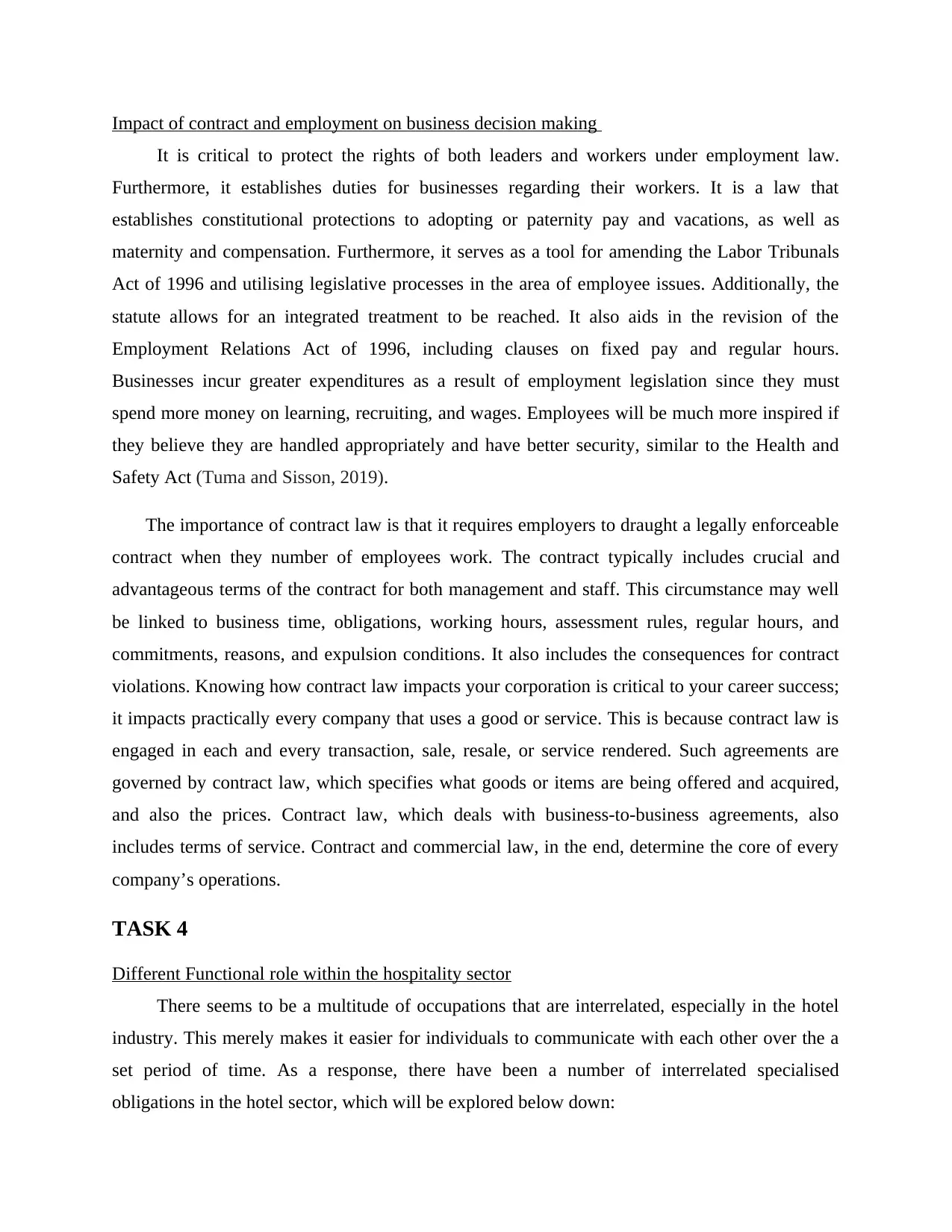
Impact of contract and employment on business decision making
It is critical to protect the rights of both leaders and workers under employment law.
Furthermore, it establishes duties for businesses regarding their workers. It is a law that
establishes constitutional protections to adopting or paternity pay and vacations, as well as
maternity and compensation. Furthermore, it serves as a tool for amending the Labor Tribunals
Act of 1996 and utilising legislative processes in the area of employee issues. Additionally, the
statute allows for an integrated treatment to be reached. It also aids in the revision of the
Employment Relations Act of 1996, including clauses on fixed pay and regular hours.
Businesses incur greater expenditures as a result of employment legislation since they must
spend more money on learning, recruiting, and wages. Employees will be much more inspired if
they believe they are handled appropriately and have better security, similar to the Health and
Safety Act (Tuma and Sisson, 2019).
The importance of contract law is that it requires employers to draught a legally enforceable
contract when they number of employees work. The contract typically includes crucial and
advantageous terms of the contract for both management and staff. This circumstance may well
be linked to business time, obligations, working hours, assessment rules, regular hours, and
commitments, reasons, and expulsion conditions. It also includes the consequences for contract
violations. Knowing how contract law impacts your corporation is critical to your career success;
it impacts practically every company that uses a good or service. This is because contract law is
engaged in each and every transaction, sale, resale, or service rendered. Such agreements are
governed by contract law, which specifies what goods or items are being offered and acquired,
and also the prices. Contract law, which deals with business-to-business agreements, also
includes terms of service. Contract and commercial law, in the end, determine the core of every
company’s operations.
TASK 4
Different Functional role within the hospitality sector
There seems to be a multitude of occupations that are interrelated, especially in the hotel
industry. This merely makes it easier for individuals to communicate with each other over the a
set period of time. As a response, there have been a number of interrelated specialised
obligations in the hotel sector, which will be explored below down:
It is critical to protect the rights of both leaders and workers under employment law.
Furthermore, it establishes duties for businesses regarding their workers. It is a law that
establishes constitutional protections to adopting or paternity pay and vacations, as well as
maternity and compensation. Furthermore, it serves as a tool for amending the Labor Tribunals
Act of 1996 and utilising legislative processes in the area of employee issues. Additionally, the
statute allows for an integrated treatment to be reached. It also aids in the revision of the
Employment Relations Act of 1996, including clauses on fixed pay and regular hours.
Businesses incur greater expenditures as a result of employment legislation since they must
spend more money on learning, recruiting, and wages. Employees will be much more inspired if
they believe they are handled appropriately and have better security, similar to the Health and
Safety Act (Tuma and Sisson, 2019).
The importance of contract law is that it requires employers to draught a legally enforceable
contract when they number of employees work. The contract typically includes crucial and
advantageous terms of the contract for both management and staff. This circumstance may well
be linked to business time, obligations, working hours, assessment rules, regular hours, and
commitments, reasons, and expulsion conditions. It also includes the consequences for contract
violations. Knowing how contract law impacts your corporation is critical to your career success;
it impacts practically every company that uses a good or service. This is because contract law is
engaged in each and every transaction, sale, resale, or service rendered. Such agreements are
governed by contract law, which specifies what goods or items are being offered and acquired,
and also the prices. Contract law, which deals with business-to-business agreements, also
includes terms of service. Contract and commercial law, in the end, determine the core of every
company’s operations.
TASK 4
Different Functional role within the hospitality sector
There seems to be a multitude of occupations that are interrelated, especially in the hotel
industry. This merely makes it easier for individuals to communicate with each other over the a
set period of time. As a response, there have been a number of interrelated specialised
obligations in the hotel sector, which will be explored below down:
Paraphrase This Document
Need a fresh take? Get an instant paraphrase of this document with our AI Paraphraser

Housekeeping teams and a front office Its cleaning functionality is an essential feature of a
product like this since it has a significant impact on the customer experience. It also guarantees
that all apartments, doors, hallways, toilets, and other common areas are clean and ready to use,
and how the head office personnel interacts with visitors. Employees are essential for securing
that customers are welcomed in a friendly and thoughtful way, as well as that accommodations
are delivered to visitors in accordance with their bookings (Etherton‐Beer and et.al, 2021). As a
consequence, front-office managerial activities and housekeeping divisions are tightly
intertwined. Their maintenance crew keeps a front offices role informed on the cleanliness of the
place, which helps them do their tasks appropriately. It can also be used to greet customers at
certain times.
Those food manufacturing and distribution units are actually linked. The food production
department is in charge of making meals, while the leadership team focuses on developing
successful advertising methods to sell the company’s products and services. As a consequence,
this section becomes networked in order to provide delectable meals to certain of its clientele at a
certain period. As a consequence, it's possible to assume that many positions in the hospitality
business are linked. This makes it easier for people to communicate with one another over a
certain period of time.
Communication methods and levels used in an organisation
One of the most important requirements for establishing a successful business is effective
communication inside the organisation. It is a crucial aspect of any current skills because of its
influence on employee involvement, teamwork, organizational confidence, and workplace
culture.
Formal communication: This type of communication is linked to the company framework as well
as the communicator's and recipient's official rank or position. It passes via the proper channels
to reach formally approved places in the organisation structure. The majority of official meetings
is in black background.
Informal communication: Grapevine is another term for informal communication. But it is used
on informal networks between the partners, including such acquaintance or participation in same
organization or group; it is devoid of any procedures (Yuan, Tseng and Ho, 2019). Whenever it's
product like this since it has a significant impact on the customer experience. It also guarantees
that all apartments, doors, hallways, toilets, and other common areas are clean and ready to use,
and how the head office personnel interacts with visitors. Employees are essential for securing
that customers are welcomed in a friendly and thoughtful way, as well as that accommodations
are delivered to visitors in accordance with their bookings (Etherton‐Beer and et.al, 2021). As a
consequence, front-office managerial activities and housekeeping divisions are tightly
intertwined. Their maintenance crew keeps a front offices role informed on the cleanliness of the
place, which helps them do their tasks appropriately. It can also be used to greet customers at
certain times.
Those food manufacturing and distribution units are actually linked. The food production
department is in charge of making meals, while the leadership team focuses on developing
successful advertising methods to sell the company’s products and services. As a consequence,
this section becomes networked in order to provide delectable meals to certain of its clientele at a
certain period. As a consequence, it's possible to assume that many positions in the hospitality
business are linked. This makes it easier for people to communicate with one another over a
certain period of time.
Communication methods and levels used in an organisation
One of the most important requirements for establishing a successful business is effective
communication inside the organisation. It is a crucial aspect of any current skills because of its
influence on employee involvement, teamwork, organizational confidence, and workplace
culture.
Formal communication: This type of communication is linked to the company framework as well
as the communicator's and recipient's official rank or position. It passes via the proper channels
to reach formally approved places in the organisation structure. The majority of official meetings
is in black background.
Informal communication: Grapevine is another term for informal communication. But it is used
on informal networks between the partners, including such acquaintance or participation in same
organization or group; it is devoid of any procedures (Yuan, Tseng and Ho, 2019). Whenever it's

tough to get feedback from clients, executives use verbal communication. Remarks,
recommendations, and other channels of technology are examples of this type of communication.
A single glance, movement, grin, or even silence might express it.
Downward communication: Downward communication refers to communication that passes
from supervisors to employees. Managers must apply their authority to accomplish the targeted
outcome in an organisation culture that means they may be providing commands, directions, and
subsequent implementation to those at lower levels. This is referred to as downward
communication. Physical working capacity is critical when gradually lose is used.
Horizontal communication: This sort of organisational communication takes place between
teams, organisations, or people working simultaneously stage in the process. Horizontal
communication is critical for breaking down organisational silos and promoting border
cooperation. It is crucial in bringing together the IT, promotion, and salespeople and ensuring
that were all on the same path (French and Bendfeldt, 2020).
CONCLUSION
According to the findings of the format prescribed, several career pathways in human
managing have existed at various times throughout their lives. Many of the stages include
recruiting, integration, retention, and progression. Maintaining and growing employees in the
hotel sector is crucial. In order to address issues such as poor conduct and staff retention, the
firm need not only design but also create a behaviour action plan. The rules of each hotel
industry must be satisfied and obeyed by a corporation. Businesses in the hotel industry must
adhere to a variety of commercial, human, and public procurement regulations. Such companies
exist solely to provide a nice and healthy atmosphere, and also facilities that aid customers in
attaining appropriate and useful necessities.
recommendations, and other channels of technology are examples of this type of communication.
A single glance, movement, grin, or even silence might express it.
Downward communication: Downward communication refers to communication that passes
from supervisors to employees. Managers must apply their authority to accomplish the targeted
outcome in an organisation culture that means they may be providing commands, directions, and
subsequent implementation to those at lower levels. This is referred to as downward
communication. Physical working capacity is critical when gradually lose is used.
Horizontal communication: This sort of organisational communication takes place between
teams, organisations, or people working simultaneously stage in the process. Horizontal
communication is critical for breaking down organisational silos and promoting border
cooperation. It is crucial in bringing together the IT, promotion, and salespeople and ensuring
that were all on the same path (French and Bendfeldt, 2020).
CONCLUSION
According to the findings of the format prescribed, several career pathways in human
managing have existed at various times throughout their lives. Many of the stages include
recruiting, integration, retention, and progression. Maintaining and growing employees in the
hotel sector is crucial. In order to address issues such as poor conduct and staff retention, the
firm need not only design but also create a behaviour action plan. The rules of each hotel
industry must be satisfied and obeyed by a corporation. Businesses in the hotel industry must
adhere to a variety of commercial, human, and public procurement regulations. Such companies
exist solely to provide a nice and healthy atmosphere, and also facilities that aid customers in
attaining appropriate and useful necessities.
⊘ This is a preview!⊘
Do you want full access?
Subscribe today to unlock all pages.

Trusted by 1+ million students worldwide
1 out of 14
Related Documents
Your All-in-One AI-Powered Toolkit for Academic Success.
+13062052269
info@desklib.com
Available 24*7 on WhatsApp / Email
![[object Object]](/_next/static/media/star-bottom.7253800d.svg)
Unlock your academic potential
Copyright © 2020–2025 A2Z Services. All Rights Reserved. Developed and managed by ZUCOL.





